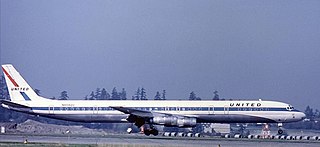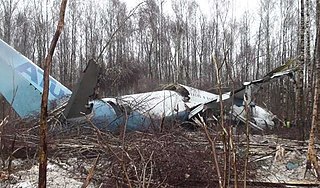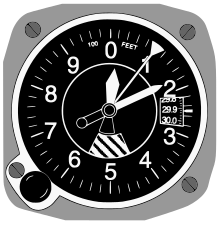
The Tenerife airport disaster occurred on March 27, 1977, when two Boeing 747 passenger jets collided on the runway at Los Rodeos Airport on the Spanish island of Tenerife. The collision occurred when KLM Flight 4805 initiated its takeoff run during dense fog while Pan Am Flight 1736 was still on the runway. The impact and resulting fire killed everyone on board KLM 4805 and most of the occupants of Pan Am 1736, with only 61 survivors in the front section of the aircraft, resulting in the worst aviation disaster in Spain. With 583 fatalities, the disaster is also the third deadliest incident and the deadliest accident in aviation history.

Aviation safety is the study and practice of managing risks in aviation. This includes preventing aviation accidents and incidents through research, educating air travel personnel, passengers and the general public, as well as the design of aircraft and aviation infrastructure. The aviation industry is subject to significant regulation and oversight.

Saudia Flight 163 was a scheduled Saudia passenger flight departing from Quaid-E-Azam Airport in Karachi, Pakistan, bound for Kandara Airport in Jeddah, Saudi Arabia, via Riyadh International Airport in Riyadh, Saudi Arabia, which caught fire after takeoff from Riyadh International Airport on 19 August 1980. Although the Lockheed L-1011-200 TriStar made a successful emergency landing at Riyadh, the flight crew failed to perform an emergency evacuation of the airplane, leading to the deaths of all 287 passengers and 14 crew on board the aircraft from smoke inhalation.
Crew resource management or cockpit resource management (CRM) is a set of training procedures for use in environments where human error can have devastating effects. CRM is primarily used for improving aviation safety and focuses on interpersonal communication, leadership, and decision making in aircraft cockpits. Its founder is David Beaty, a former Royal Air Force and a BOAC pilot who wrote "The Human Factor in Aircraft Accidents" (1969). Despite the considerable development of electronic aids since then, many principles he developed continue to prove effective.

Copa Airlines Flight 201 was a regularly scheduled passenger flight from Tocumen International Airport in Panama City, Panama, to Alfonso Bonilla Aragón International Airport in Cali, Colombia. On 6 June 1992, the Boeing 737-204 Advanced operating the route rolled, entered a steep dive, disintegrated in mid-air, and crashed into the jungle of the Darién Gap 29 minutes after takeoff, killing all 47 people on board. The in-flight break-up was caused by faulty instrument readings and several other contributing factors, including incomplete training.

Gulf Air Flight 072 (GF072/GFA072) was a scheduled international passenger flight from Cairo International Airport in Egypt to Bahrain International Airport in Bahrain, operated by Gulf Air. On 23 August 2000 at 19:30 Arabia Standard Time (UTC+3), the Airbus A320 crashed minutes after executing a go-around upon failed attempt to land on Runway 12. The flight crew suffered from spatial disorientation during the go-around and crashed into the shallow waters of the Persian Gulf 2 km (1 nmi) from the airport. All 143 people on board the aircraft were killed.

United Airlines Flight 173 was a scheduled flight from John F. Kennedy International Airport in New York City to Portland International Airport in Portland, Oregon, with a scheduled stop in Denver, Colorado. On December 28, 1978, the aircraft flying this route ran out of fuel while troubleshooting a landing gear problem and crashed in a suburban Portland neighborhood near NE 157th Avenue and East Burnside Street, killing 10 on board.

One-Two-Go Airlines Flight 269 (OG269) was a scheduled domestic passenger flight from Bangkok to Phuket, Thailand. On 16 September 2007, about 15:41 ICT, the McDonnell Douglas MD-82 operating the flight crashed into an embankment beside runway 27 at Phuket International Airport (HKT) bursting into flames upon impact during an attempted go-around after an aborted landing, killing 90 of the 130 persons on board. It is the third deadliest aviation incident to occur in Thailand.

Aviastar-TU Flight 1906 was a Tupolev Tu-204 that crashed while attempting to land at Domodedovo International Airport, Moscow, Russia, in heavy fog on 22 March 2010. The aircraft was on a ferry flight from Hurghada International Airport, Egypt to Moscow, and had no passengers on board; all eight crew survived the accident, four with serious injuries requiring hospitalization and four with minor injuries. The accident was the first hull loss of a Tu-204 and the first hull loss for Aviastar-TU.
In aeronautics, loss of control (LOC) is the unintended departure of an aircraft from controlled flight and is a significant factor in several aviation accidents worldwide. In 2015 it was the leading cause of general aviation accidents. Loss of control may be the result of mechanical failure, external disturbances, aircraft upset conditions, or inappropriate crew actions or responses.

Asiana Airlines Flight 162 was a regular short-haul international passenger flight from Incheon International Airport near Seoul, South Korea, to Hiroshima Airport in Hiroshima, Japan. On 14 April 2015, the Airbus A320-232 aircraft touched down short of the runway, struck the localizer array, skidded onto the runway on its tail, and spun 120 degrees before finally coming to a rest on the grass, opposite the terminal building. The aircraft suffered substantial damage to the left wing and engine. Of the 82 people aboard, 27 were injured, one seriously.
Pilot decision making, also known as aeronautical decision making (ADM), is a process that aviators perform to effectively handle troublesome situations that are encountered. Pilot decision-making is applied in almost every stage of the flight as it considers weather, air spaces, airport conditions, estimated time of arrival and so forth. During the flight, employers pressure pilots regarding time and fuel restrictions since a pilots’ performance directly affects the company’s revenue and brand image. This pressure often hinders a pilot's decision-making process leading to dangerous situations as 50% to 90% of aviation accidents are the result of pilot error.

Culture can affect aviation safety through its effect on how the flight crew deals with difficult situations; cultures with lower power distances and higher levels of individuality can result in better aviation safety outcomes. In higher power cultures subordinates are less likely to question their superiors. The crash of Korean Air Flight 801 in 1997 was attributed to the pilot's decision to land despite the junior officer's disagreement, while the crash of Avianca Flight 052 was caused by the failure to communicate critical low-fuel data between pilots and controllers, and by the failure of the controllers to ask the pilots if they were declaring an emergency and assist the pilots in landing the aircraft. The crashes have been blamed on aspects of the national cultures of the crews.

Stress in the aviation industry is a common phenomenon composed of three sources: physiological stressors, psychological stressors, and environmental stressors. Professional pilots can experience stress in flight, on the ground during work-related activities, and during personal time because of the influence of their occupation. An airline pilot can be an extremely stressful job due to the workload, responsibilities and safety of the thousands of passengers they transport around the world. Chronic levels of stress can negatively impact one's health, job performance and cognitive functioning. Being exposed to stress does not always negatively influence humans because it can motivate people to improve and help them adapt to a new environment. Unfortunate accidents start to occur when a pilot is under excessive stress, as it dramatically affects his or her physical, emotional, and mental conditions. Stress "jeopardizes decision-making relevance and cognitive functioning" and it is a prominent cause of pilot error. Being a pilot is considered a unique job that requires managing high workloads and good psychological and physical health. Unlike the other professional jobs, pilots are considered to be highly affected by stress levels. One study states that 70% of surgeons agreed that stress and fatigue don't impact their performance level, while only 26% of pilots denied that stress influences their performance. Pilots themselves realize how powerful stress can be, and yet many accidents and incidents continues to occur and have occurred, such as Asiana Airlines Flight 214, American Airlines Flight 1420, and Polish Air Force Tu-154.

Tropical Airways Flight 1301 (TBG1301/M71301) was a domestic short-haul passenger flight, flying from Cap-Haïtien International Airport in Cap-Haïtien, Haiti to the commune of Port-de-Paix which crashed onto a sugarcane field less than 10 minutes after take off on the evening of 24 August 2003. The aircraft was a 19-seater Let L-410 Turbolet carrying 19 passengers and 2 crew. Witnesses stated that the aircraft caught fire during take-off and exploded when it hit the ground. All on board were killed.

Air India Express Flight 1344 was a scheduled international flight on 7 August 2020 from Dubai, United Arab Emirates, to Kozhikode, India, landing at Calicut International Airport. The flight was part of the Vande Bharat Mission to repatriate Indian nationals stranded due to the COVID-19 pandemic. The flight crew aborted two landing attempts because of heavy rain and tailwind. On the third landing attempt, the aircraft touched down on runway 10, but skidded off the end of the tabletop runway and slid down a 9–10.5 m (30–35 ft) slope, killing 19 passengers and both pilots. The four cabin crew members and 165 passengers survived, of whom all but two were injured. This was the second fatal accident involving Air India Express, after the 2010 Mangalore crash.




















